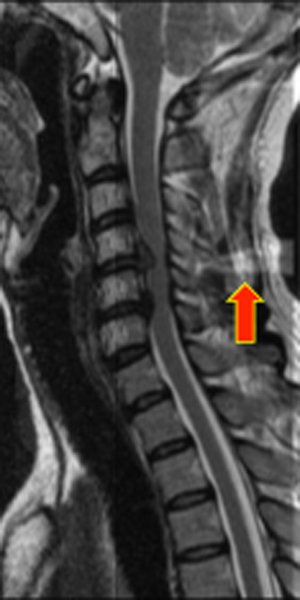|
In the prior Q&A we showed how the field-of- view (FOV) is inversely related to the spacing (Δk) of samples in k-space. For simplicity of explanation we considered square pixels with the same FOV in each direction. However, by altering the sampling rates along the frequency and phase axes it is possible to alter the FOV along each image dimension independently.
FOVf = 1 / Δkf
FOVp = 1 / Δkp |
For 2D-spin warp imaging, a rectangular FOV with a 1:2 ratio is obtained by sampling alternate phase-encode lines in k-space while leaving the maximum and minimum amplitudes of the phase-encoding gradient unchanged. This process halves the number of phase-encoding steps (Np), but doubles the increment between successive steps.
The sampling rate and hence the field-of-view in the frequency-encode direction (FOVf) remains unaffected. Furthermore, because both the FOVp and Np have been reduced by one-half, pixel size in the phase-encode direction (FOVp / Np) and overall spatial resolution of the image are also unchanged.
|
All MR manufacturers offer rectangular FOV as a standard option applicable to most pulse sequences. The names differ slightly by vendor: "Rectangular FOV" (Philips, Hitachi, Canon), "Phase FOV" (Siemens), and "Partial FOV" (GE).
The rectangular FOV option is most beneficial in imaging the spine and extremities, where one anatomical dimension is much longer than the other. Most scanners allow adjusting the phase-sampling ratio over a large range; accordingly, considerable latitude may be permitted in the size and shape of the rectangular FOV.
Rectangular FOV techniques have two major drawbacks, however. First, because fewer phase-encoding steps are acquired, the signal-to-noise ratio (SNR) is proportionately lower compared to full FOV imaging. Secondly, wrap-around (aliasing) in the phase-encoding direction may occur if the object dimensions exceed this defined FOVp. Careful positioning of the patient and the use of saturation bands may be needed to eliminate this artifact.
|
Advanced Discussion (show/hide)»
No supplementary material yet. Check back soon!
References
Mezrich R. A perspective on k-space. Radiology 1995; 195: 297-315. [review].
Miller K. MRI image formation (ppt). On-line lecture notes available atusers.fmrib.ox.ac.uk/~karla/teaching/image_formation.ppt
Mezrich R. A perspective on k-space. Radiology 1995; 195: 297-315. [review].
Miller K. MRI image formation (ppt). On-line lecture notes available atusers.fmrib.ox.ac.uk/~karla/teaching/image_formation.ppt
Related Questions
How does k-space relate to field-of-view (FOV) and pixel width?
Why does phase wrap-around occur?
How does k-space relate to field-of-view (FOV) and pixel width?
Why does phase wrap-around occur?


